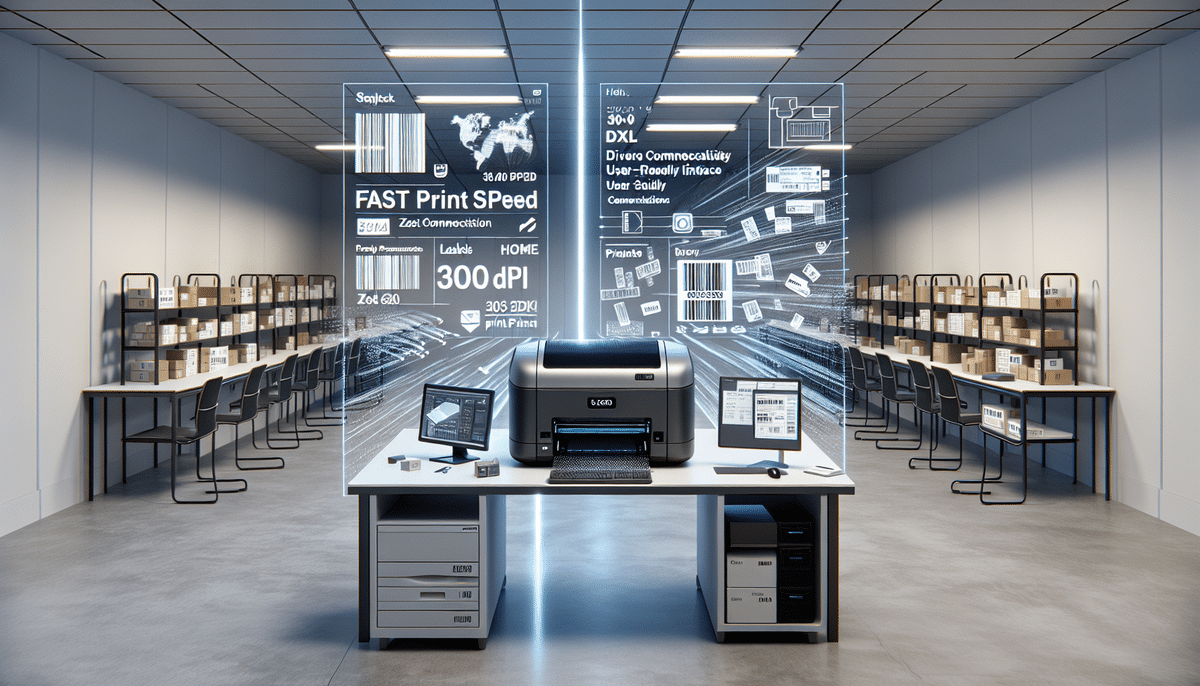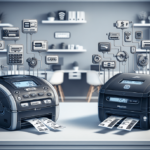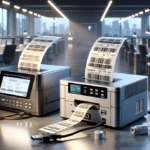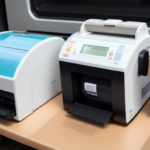Zebra ZD620 vs DYMO LabelWriter 4XL: Comprehensive Comparison for 2024
Choosing the right label printer is crucial for businesses aiming to optimize their labeling processes. The Zebra ZD620 and the DYMO LabelWriter 4XL are two prominent options in the market. This article provides an in-depth comparison of these label printers, focusing on their features, print quality, speed, connectivity options, ease of use, and pricing to help you determine which is best suited for your business needs.
Introduction to Zebra ZD620 and DYMO LabelWriter 4XL
The Zebra ZD620 and DYMO LabelWriter 4XL are both thermal label printers designed to deliver high-quality labels for various applications. While the Zebra ZD620 utilizes direct thermal printing, the DYMO LabelWriter 4XL employs thermal transfer technology, allowing it to print on a wider range of label materials.
The Zebra ZD620 is renowned for its versatility in handling different label sizes and materials, making it ideal for businesses requiring flexibility in their labeling solutions. Its user-friendly interface and seamless integration capabilities further enhance its appeal.
Conversely, the DYMO LabelWriter 4XL excels in speed and efficiency, particularly for businesses that need to print large volumes of labels quickly. Its compact design is well-suited for environments with limited workspace, and its accompanying software facilitates easy customization of labels, including the addition of barcodes and graphics.
Features and Specifications of Zebra ZD620
- Print Speed: Up to 203 mm/second, enabling rapid label production (Zebra ZD620 Specs).
- Print Resolution: 300 dpi for crisp and clear labels.
- Connectivity: USB, Ethernet, Bluetooth, and Wi-Fi, offering extensive integration options.
- Durability: Rugged metal frame with dual-wall construction for longevity in demanding environments.
- User Interface: Intuitive color LCD display for easy configuration and operation.
- Media Handling: Supports peel-and-present mode and cutter options for versatile labeling needs.
The Zebra ZD620's robust design ensures reliability, while its multiple connectivity options allow seamless integration with existing systems, enhancing productivity and efficiency.
Features and Specifications of DYMO LabelWriter 4XL
- Print Speed: Up to 53 labels per minute, suitable for high-volume printing.
- Print Resolution: 300 dpi, delivering high-quality labels.
- Label Width: Supports labels up to 4 inches wide, ideal for shipping and large-format labels.
- Connectivity: Primarily USB, with optional Wi-Fi and Ethernet features available.
- Software Integration: Compatible with DYMO Label and DYMO Connect software for customized label creation.
- Platform Compatibility: Integrates with e-commerce platforms like eBay, Amazon, and Etsy, streamlining online sales operations.
The DYMO LabelWriter 4XL is optimized for businesses that require rapid production of large labels, particularly in shipping and e-commerce sectors. Its compatibility with various software tools enhances its functionality and ease of use.
Print Quality Comparison
Both the Zebra ZD620 and DYMO LabelWriter 4XL offer superior print quality with a resolution of 300 dpi, ensuring clear and professional labels. However, their printing technologies differ, impacting label durability:
- Zebra ZD620: Utilizes direct thermal printing, which is ideal for short-term applications such as shipping labels and receipts. The labels are less durable and may fade over time, especially when exposed to heat or sunlight.
- DYMO LabelWriter 4XL: Employs thermal transfer printing, producing more durable labels that resist fading and are suitable for long-term use.
Furthermore, the Zebra ZD620's faster print speed allows for quicker label production, beneficial for businesses handling high label volumes daily.
Speed Comparison
When evaluating speed, the Zebra ZD620 outperforms the DYMO LabelWriter 4XL:
- Zebra ZD620: Prints up to 203 mm/second, drastically reducing label turnaround times.
- DYMO LabelWriter 4XL: Prints up to 53 labels per minute, which is slower but still efficient for moderate volume needs.
The Zebra ZD620's superior speed makes it more suitable for fast-paced environments where time efficiency is critical.
Connectivity Options
Connectivity is a key factor in integrating label printers into existing workflows:
- Zebra ZD620: Offers extensive connectivity options including USB, Ethernet, Bluetooth, and Wi-Fi. It also features a built-in web server for remote management and configuration, facilitating multi-device usage.
- DYMO LabelWriter 4XL: Primarily relies on USB connectivity, with optional Wi-Fi and Ethernet modules available. While sufficient for many users, it may lack the flexibility needed for more complex network environments.
The Zebra ZD620's multiple connectivity options provide greater flexibility and ease of integration with various devices and networks, making it a more versatile choice for diverse business settings.
Ease of Use Comparison
Both printers are designed with user-friendliness in mind, but they offer different conveniences:
- Zebra ZD620: Features a user-friendly interface with an intuitive color LCD display, simplifying setup and operation. Its label roll holder allows for quick label changes without manual adjustments.
- DYMO LabelWriter 4XL: Comes with straightforward software interfaces for label creation. However, it requires manual adjustment of label spools when changing label types, which can be less convenient during frequent label changes.
The Zebra ZD620's design enhances ease of use, particularly for businesses that frequently switch label types or require minimal downtime during label changes.
Price Comparison
Pricing is always a significant consideration:
- Zebra ZD620: Positioned at a higher price point, reflecting its advanced features and robust build quality. However, the investment may be justified by its durability and extensive connectivity options.
- DYMO LabelWriter 4XL: More affordable, making it an attractive option for small to medium-sized businesses. While it may lack some of the advanced features of the Zebra ZD620, it offers excellent value for its price.
Considering long-term costs, the Zebra ZD620's durability may lead to lower maintenance and replacement expenses, whereas the DYMO LabelWriter 4XL's lower initial cost and affordable replacement parts make it a cost-effective choice for businesses with budget constraints.
Which Label Printer is Best for Small Businesses?
For small businesses, the Zebra ZD620 stands out due to its combination of speed, print quality, and versatile connectivity options. While it is priced higher than the DYMO LabelWriter 4XL, its comprehensive feature set provides superior reliability and flexibility, essential for businesses with evolving labeling needs.
Additionally, the Zebra ZD620 supports a broader range of label sizes and materials, accommodating diverse labeling requirements without the need for frequent printer changes.
Which Label Printer is Best for Large-Scale Operations?
The DYMO LabelWriter 4XL is better suited for large-scale operations that demand high-volume label printing with durability. Its ability to handle larger label widths and different label types makes it ideal for shipping labels and extensive labeling tasks.
Moreover, its compatibility with various software programs, such as Microsoft Word and Excel, facilitates seamless integration into existing business processes, enhancing operational efficiency.
However, for operations requiring advanced features like barcode printing or wireless connectivity, alternatives like the Zebra ZT410 or Brother QL-1110NWB may be more appropriate.
Pros and Cons of Using the Zebra ZD620 Label Printer
Pros
- High-quality 300 dpi print resolution
- Exceptional print speed up to 203 mm/second
- User-friendly interface with intuitive controls
- Extensive connectivity options: USB, Ethernet, Bluetooth, Wi-Fi
- Rugged and durable build for long-term use
- Advanced media handling options
Cons
- Higher initial cost compared to competitors
- Direct thermal printing limits label durability
Pros and Cons of Using the DYMO LabelWriter 4XL Label Printer
Pros
- Fast print speed of up to 53 labels per minute
- Versatile handling of different label types and sizes
- Reasonably priced, offering good value for money
- Thermal transfer printing produces durable labels
- Compact design suitable for limited spaces
Cons
- Slower print speed compared to Zebra ZD620
- Manual adjustment required for label spool changes
- Limited connectivity options without additional modules
Conclusion: Which Label Printer is the Better Investment?
Both the Zebra ZD620 and the DYMO LabelWriter 4XL are exceptional label printers, each with distinct advantages tailored to different business needs. For small businesses prioritizing speed, print quality, and versatile connectivity, the Zebra ZD620 is the superior choice despite its higher price point. Its robust feature set and durable construction make it a reliable long-term investment.
On the other hand, the DYMO LabelWriter 4XL is ideal for larger operations requiring efficient, high-volume printing with the flexibility to handle various label types. Its affordability and durable thermal transfer printing make it a cost-effective solution for businesses focused on large-scale label production.
Ultimately, the decision should be based on your specific business requirements, budget, and the scale of your labeling operations. Both printers offer reliable performance and high-quality output, ensuring that whichever option you choose will significantly enhance your business's labeling efficiency.
For more detailed information and to purchase, visit ShipScience.






















